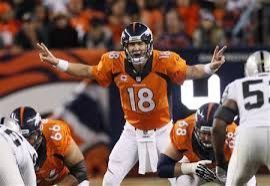Super Bowl Science: Could A Seahawk Beat A Bronco? And Other Important Nerdy Football Questions

In the words of Lisa Simpson, “what could be more exciting than the savage ballet that is pro football?” Perhaps the science of that savage ballet! In that spirit, here’s some Super Bowl science to chew on in between scoops of guacamole this weekend:
Seahawks vs. Broncos… in nature
How would the Seattle vs. Denver matchup play out in the natural world? A scrap between a seahawk and a bronco would be a very one-sided contest.
A full-grown osprey (which is often nicknamed a “sea hawk”) usually grows only up to 22-25 inches long and 2-4 pounds in weight. Augur Hawks (known as Augur Buzzard outside of the Americas) like Taima, the trained bird that leads the Seahawks onto the field for their pregrame shows in Seattle, are comparably sized.
The Denver Broncos’ mascot, Thunder II, is an Arabian horse that weighs 900 pounds. Thunder II’s exact height wasn’t immediately available, but the average Arabian horse is around five feet tall.
“There is NO WAY an osprey could take down a horse!” Pat Leonard, a spokesperson for Cornell University’s Lab of Ornithology, wrote in an email.
So, if your standard of Super Bowl betting is “which of the mascots would win in a fight,” go with Denver.
Guard Your Head
The toll of the gridiron on players’ heads is pretty grim. In 333 games played throughout the NFL season in 2012, there were 217 recorded concussions – more than one every two games, on average. Thousands of NFL players have sued the league for alleged negligence and not telling players enough about the link between concussions and brain damage. (A $765 million settlement in that suit is on the table, but it has many critics – including the family of the late star Junior Seau, who say the star’s 2012 suicide was a reaction to a chronic brain disease).
How can football players’ heads be better protected? Sometimes football helmets and mouth guards are advertised as reducing a player’s risk of concussion. But scientists who’ve tested the equipment beg to differ. A University of Wisconsin-Madison-led team tracked 1,332 high school football players during their 2012 seasons. They found that there was essentially no difference in concussion rates by brand of football helmet worn.
Slightly better football injury-related news came earlier this month from the University of Rochester, where researchers think that it might be possible to diagnose concussions right on the field. The key is a protein called S100B. In their research, the scientists have found that levels of this protein rise in the brain right after a concussion, by a significant level. So, after a player takes a bad hit, it might be possible for a team’s doctor to take a small blood sample from a finger-stick and tell very shortly whether or not they’ve experienced a concussion.
Keeping the "foot" in "football"
Despite the fact that football is a passing game, footwear is key out on the field. Cleats were originally a very DIY affair, with players hammering leather or metal studs into their work boots. But the cleat of today is a hyper-engineered affair, with stud placement and even shape going under the microscope. One of the latest design fads in football cleats is blade-like, L-shaped studs that are more ideal for players looking to quickly change direction in response to an opposing player’s movements.
“We found [that] players tend to stop and break first,” Adidas football unit director Jeff McGillis told Sports Illustrated last November. “you stop with your heel and get back up on the forefoot. With the old circular stud types, you can slip and slide… the blade L-shapes [stop] quickly, allowing you to get back on your toes and change directions.”
The arrangement of studs on a cleat is also taken into account by shoemakers. Some cleats are sport-specific -- a soccer player’s movements are going to be very different from an American football player’s. And even different members of a football team might need different performances from their cleats. Some cleats have studs arranged more towards the front of the sole, the better for cornerbacks to make sharp, quick cuts across the field. Cleats for a receiver might have fewer, shorter studs to provide some initial grip on the turf for the first few steps, but which won’t glue him to the ground after he gets up to speed.
© Copyright IBTimes 2024. All rights reserved.





















